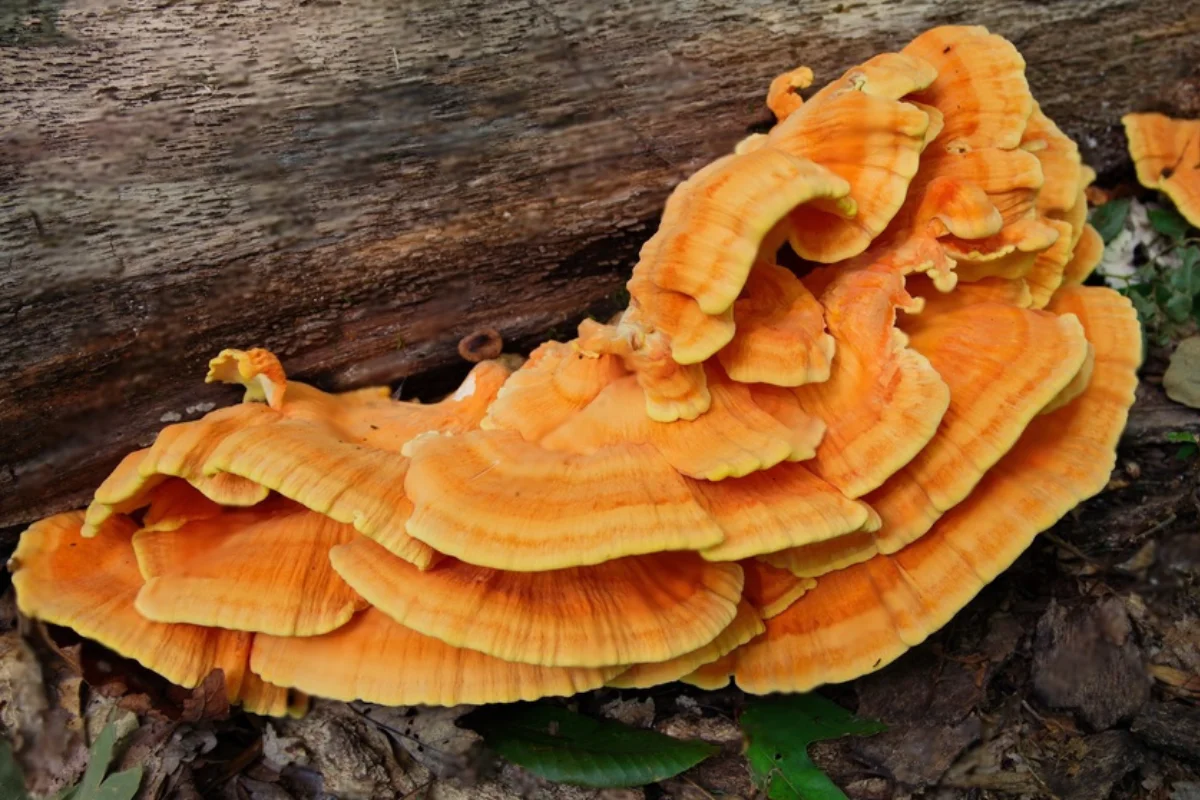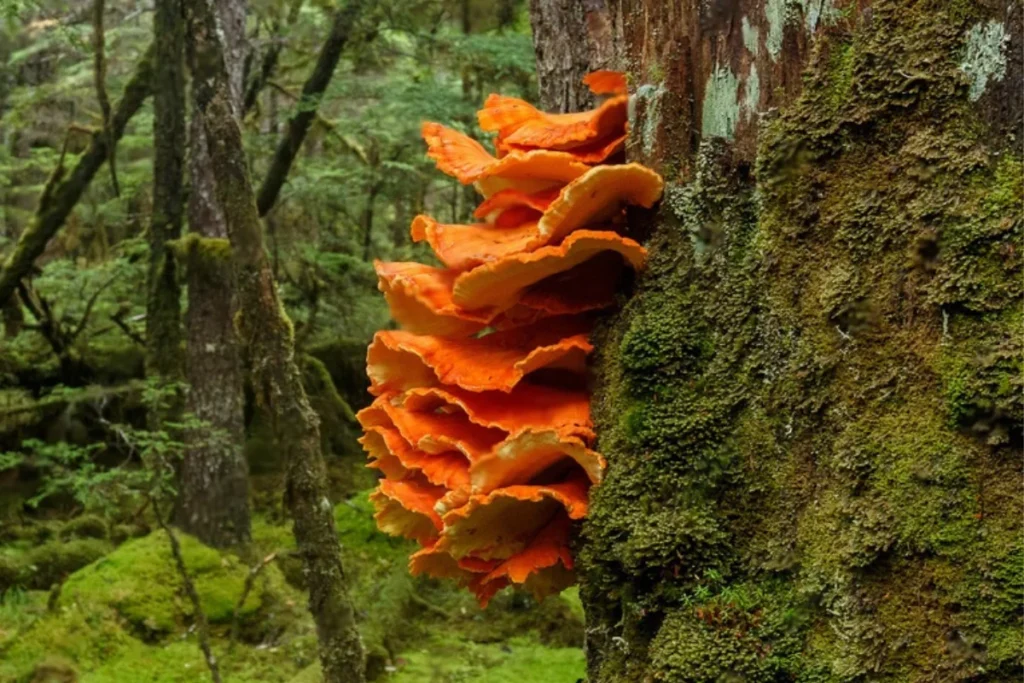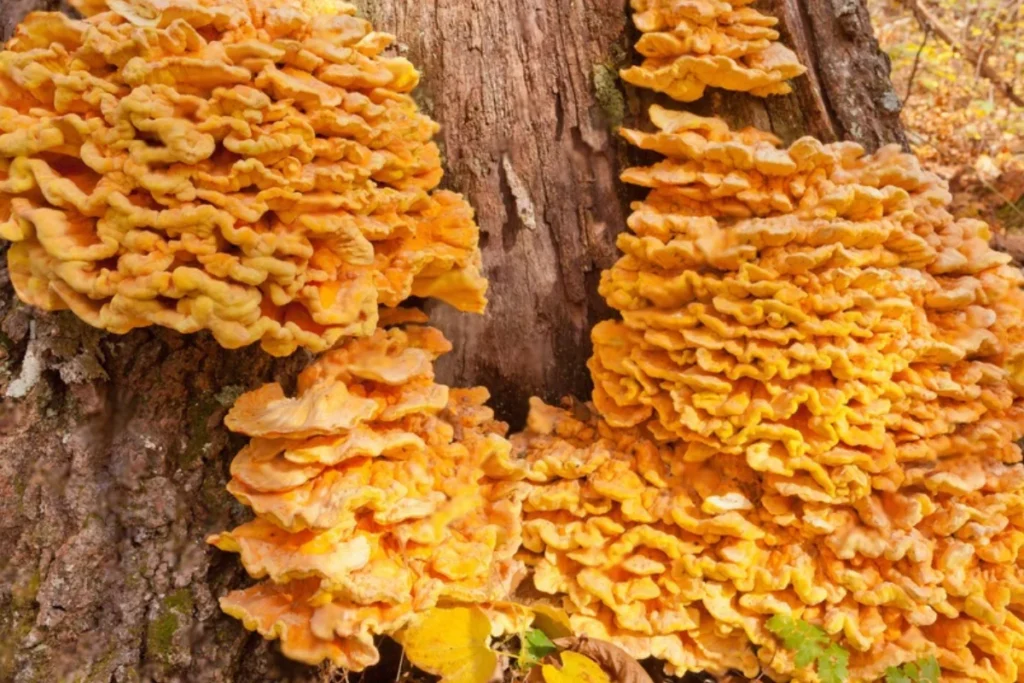Chicken of the Woods, a distinctive mushroom, stands out for its meaty flavor and texture. Known scientifically as Laetiporus, this fungus is celebrated for its culinary versatility and nutritional benefits. It thrives on the sides of trees, showcasing a vibrant yellow to orange color palette.
- Laetiporus cincinnatus and Laetiporus sulphureus are its main species, each with unique characteristics.
- Found primarily in wooded areas, these mushrooms serve as a substantial meat substitute.
For those interested in exploring the culinary potential of Chicken of the Woods, Mushroom Appreciation delves into its identification and foraging, ensuring enthusiasts can safely enjoy this forest treasure.
Distinctive Features and Identification
Chicken of the Woods mushrooms are easily identifiable by their unique characteristics:
- They exhibit a bright yellow to orange color, making them stand out in their natural habitat.
- The mushrooms grow in broad, fan-shaped clusters on tree sides, resembling small shelves.
- Unlike many mushrooms, Chicken of the Woods does not have gills. Instead, its underside may be smooth or feature tiny pores.
- As they age, their color can fade to a paler shade, adding to their distinctive appearance.
Identification is straightforward, thanks to these features. Foragers can confidently distinguish Chicken of the Woods from other species. Moreover, their growth on hardwood trees, particularly oaks, provides additional clues for identification. This mushroom’s striking presence not only enriches forest biodiversity but also offers foragers and chefs a prized ingredient.
Species of Chicken of the Woods
The Chicken of the Woods mushroom encompasses several species, each with distinct traits:
- Laetiporus cincinnatus is known for its creamy white underside. It typically grows at the base of trees, favoring oaks.
- Laetiporus sulphureus, or the Sulfur Shelf, displays a bright yellow underside. This species prefers to grow on the sides of trees.
Both species share the meaty texture and flavor that make Chicken of the Woods a sought-after culinary ingredient. They can be found across various regions, thriving in wooded areas and contributing to the ecosystem by decomposing dead wood. Each species offers a unique foraging experience, with their vibrant colors and substantial size making them easy to spot. Foragers and chefs alike treasure these mushrooms for their versatility in dishes and nutritional value.
Taste Profile and Texture
Chicken of the Woods mushrooms are celebrated for their remarkable culinary attributes, particularly their taste and texture. These fungi offer a unique sensory experience, distinguishing them from other edible mushrooms.
- Taste: The flavor of Chicken of the Woods is notably meaty, with a mild, lemony undertone. This distinctive taste is reminiscent of chicken, hence the name, and sometimes compared to lobster or crab. The subtle citrus note adds a refreshing complexity to its flavor profile, making it a versatile ingredient in a variety of dishes.
- Texture: When cooked, Chicken of the Woods mushrooms have a tender yet firm texture, similar to well-cooked poultry. This texture is a key factor in its popularity as a meat substitute in vegetarian and vegan cooking. The mushrooms’ ability to absorb flavors while maintaining their structural integrity allows them to stand out in stews, stir-fries, and grilled dishes.
The combination of its unique taste and satisfying texture makes Chicken of the Woods a prized find for foragers and a beloved ingredient among chefs. Its culinary flexibility allows it to be used in traditional mushroom recipes, as well as innovative dishes that cater to a wide range of dietary preferences. For more insights into the world of mushrooms and their culinary uses, check out our guide on what makes a great mushroom dish.
Cooking Techniques and Recipes
Chicken of the Woods mushrooms are as versatile in cooking as they are distinctive in flavor and texture. Their robust nature allows for a variety of cooking techniques, each enhancing the mushroom’s natural qualities.
- Sautéing: A popular method that highlights the mushroom’s meaty texture. Sautéed with garlic, onions, or shallots, Chicken of the Woods can transform a simple dish into a gourmet experience.
- Frying: Battered and fried, these mushrooms make an excellent vegetarian alternative to fried chicken, offering a crispy exterior with a tender, flavorful interior.
- Baking: Baked Chicken of the Woods can be a centerpiece of a meal. Marinated and then baked, it absorbs flavors well, making it a hearty addition to any table.
- Blanching: Blanching before cooking can soften the mushrooms, making them more palatable and easier to digest, especially for larger, older specimens.
Recipes that showcase Chicken of the Woods include:
- Mushroom Risotto: Incorporating sautéed mushrooms for a rich, umami-packed dish.
- Vegetarian Stir-fry: Adding a meaty texture to a vibrant mix of vegetables.
- Mushroom Tacos: Using shredded mushrooms as a filling, seasoned with traditional taco spices for a vegetarian twist.
These cooking techniques and recipes allow Chicken of the Woods to shine, offering delicious and innovative ways to enjoy this unique mushroom. For more unique recipe ideas, explore our delicious Chicken of the Woods recipes.
Nutritional Value and Health Benefits
Chicken of the Woods mushrooms are not only a culinary delight but also a nutritional powerhouse. These fungi offer a range of health benefits, making them a valuable addition to any diet.
- High in Protein: With a higher protein content than most other mushrooms, Chicken of the Woods is an excellent meat substitute, particularly for vegetarians and vegans.
- Rich in Vitamins and Minerals: These mushrooms are a good source of Vitamin C, Vitamin D, potassium, and fiber, contributing to overall health and well-being.
- Antioxidant Properties: They contain antioxidants, which help in fighting free radicals, reducing inflammation, and potentially lowering the risk of chronic diseases.
- Low in Fat and Calories: Making them an ideal choice for those looking to maintain or lose weight while still enjoying flavorful and satisfying meals.
The nutritional profile of Chicken of the Woods supports immune system health, aids in digestion, and can contribute to heart health. Its inclusion in regular diets can offer a delicious way to enjoy various health benefits, aligning with a lifestyle focused on wellness and natural, whole foods.
Chicken of the Woods vs. Other Mushrooms
Comparison with Hen of the Woods
While both Chicken of the Woods and Hen of the Woods are popular edible mushrooms, they have distinct differences in appearance, taste, and culinary uses.
- Appearance: Chicken of the Woods is known for its vibrant yellow to orange color, while Hen of the Woods presents a more muted gray or brown, resembling the ruffled tail feathers of a hen.
- Taste: Chicken of the Woods offers a meaty, slightly lemony flavor, making it a favorite for its chicken-like taste. In contrast, Hen of the Woods has a deeper, earthier flavor, often used to enhance the umami in dishes.
- Culinary Uses: Due to its texture and taste, Chicken of the Woods is often used as a meat substitute in a variety of dishes. Hen of the Woods, however, is prized for its ability to add depth to soups, stews, and sautéed dishes.
Understanding these differences can help chefs and foragers make informed choices about which mushroom to use in their cooking, depending on the desired flavor profile and texture.
Unique Characteristics of Chicken of the Woods
Chicken of the Woods stands out in the fungal kingdom due to its unique set of characteristics:
- Vibrant Coloration: Its striking yellow to orange hues make it easily identifiable in the wild, a visual cue that’s as appealing to the eye as it is to the palate.
- Meaty Texture: This mushroom’s firm, meat-like texture is unparalleled among edible fungi, offering a satisfying chew that’s akin to chicken or lobster.
- Versatile Culinary Uses: Its ability to absorb flavors while maintaining its texture allows it to be a star ingredient in a wide range of dishes, from stir-fries to vegan “chicken” recipes.
- Nutritional Benefits: High in protein, vitamins, and minerals, yet low in fat and calories, it’s a healthful choice for those looking to add nutritious elements to their diet.
- Ease of Identification: For foragers, the distinctive look and growth pattern of Chicken of the Woods reduces the risk of mistaking it for inedible or toxic species.
These characteristics not only make Chicken of the Woods a sought-after delicacy but also a fascinating subject of study in the world of mycology.
Conservation and Ethical Foraging
Sustainable Foraging Practices
Sustainable foraging of Chicken of the Woods ensures the preservation of this valuable resource for future generations. Adhering to responsible practices is crucial:
- Harvest Mature Specimens Only: Leave younger mushrooms to grow and reproduce. Mature mushrooms are typically larger and have fully developed their vibrant colors.
- Take What You Need: Overharvesting can deplete local populations. Harvest only what you can consume to allow for regeneration.
- Use a Knife: Cut the mushroom carefully without damaging the host tree or the mycelium, ensuring future growth.
- Respect Wildlife and Habitat: Be mindful of the ecosystem. Avoid disturbing the natural habitat and other species that rely on these mushrooms.
- Educate Yourself: Proper identification is key to avoiding the collection of protected or poisonous species. Knowledge of local regulations and protected areas is also essential.
By following these guidelines, foragers can enjoy the bounty of nature while contributing to the conservation of Chicken of the Woods and its environment.
Conservation Concerns
The popularity of foraging for Chicken of the Woods mushrooms raises important conservation concerns. As enthusiasts seek out these fungi, the impact on natural habitats and the species’ sustainability comes into focus:
- Habitat Disturbance: Increased foot traffic in sensitive ecosystems can disrupt local flora and fauna. It’s vital to minimize impact by sticking to established paths and leaving areas as they were found.
- Sustainability: With the growing interest in wild mushrooms, there’s a risk of overharvesting. Sustainable practices are essential to ensure Chicken of the Woods remains a part of the ecosystem.
- Biodiversity: These mushrooms play a crucial role in forest ecosystems, aiding in the decomposition of wood and contributing to nutrient cycles. Their removal can affect biodiversity.
- Education and Awareness: Promoting awareness about the ecological role of Chicken of the Woods and the importance of conservation-minded foraging can help mitigate negative impacts.
Addressing these concerns is key to preserving the natural abundance of Chicken of the Woods for future generations to enjoy and benefit from.
FAQs about Chicken of the Woods
What does Chicken of the Woods taste like?
Chicken of the Woods has a meaty texture and a taste reminiscent of chicken, with a slight lemony undertone. Its unique flavor makes it a popular choice for culinary use, especially as a meat substitute in vegetarian and vegan dishes.
How do you identify Chicken of the Woods?
This mushroom is identifiable by its vibrant yellow to orange color, fan-shaped growth on the sides of trees, and the absence of gills. It typically grows in overlapping layers and can be found on hardwoods, especially oaks.
Can you eat Chicken of the Woods raw?
It is not recommended to eat Chicken of the Woods raw due to potential indigestibility and the risk of mild reactions. Cooking it thoroughly is the best way to enjoy its flavor and texture safely.
How do you cook Chicken of the Woods?
Chicken of the Woods can be cooked in various ways, including sautéing, frying, baking, and blanching. It’s versatile in recipes, from stir-fries and risottos to vegan “chicken” dishes. Cooking brings out its tender texture and rich flavor.
Where can you find Chicken of the Woods?
This mushroom is commonly found on the sides of living or dead hardwood trees, such as oaks. It grows in forests, woodlands, and sometimes in urban areas with suitable trees.
Is Chicken of the Woods safe for everyone?
While Chicken of the Woods is generally considered safe to eat, some individuals may experience gastrointestinal upset or allergic reactions. It’s advisable to try a small amount first if you’re new to this mushroom.
How do you store Chicken of the Woods?
After harvesting, you should clean Chicken of the Woods and store it in a paper bag in the refrigerator, where it stays fresh for up to a week. For extended storage, cook and then freeze it.
Does Chicken of the Woods have any health benefits?
Yes, Chicken of the Woods is rich in protein, fiber, vitamins (including Vitamin C and D), and minerals. It’s also low in fat and calories, making it a nutritious addition to diets.
Conclusion
Chicken of the Woods is more than just a mushroom; it’s a culinary treasure and an ecological marvel. With its vibrant colors, meaty texture, and versatile flavor profile, it offers a unique alternative to traditional meats and a delightful ingredient for a wide range of dishes. Foragers and chefs alike cherish this mushroom for its taste, nutritional benefits, and the joy of discovery it brings to the great outdoors.
However, the increasing popularity of foraging for Chicken of the Woods underscores the importance of sustainable practices and conservation awareness. By adhering to responsible harvesting methods, enthusiasts can ensure that this remarkable fungus remains a part of our natural and culinary landscapes for generations to come.
Whether you’re a seasoned forager, a culinary adventurer, or simply curious about the natural world, Chicken of the Woods provides a fascinating glimpse into the diversity and bounty of nature. Its role in the ecosystem, as well as in our kitchens, highlights the interconnectedness of all living things and the importance of preserving the delicate balance of our environment.
In embracing Chicken of the Woods, we find not only a source of nourishment and pleasure but also a reminder of our responsibility to the planet and to each other. Let us continue to explore, enjoy, and protect the natural wonders that surround us, for in them lies the true spice of life.


